Impact of COVID-19 Restrictions and Traffic Intensity on Urban Stormwater Quality in Denver, Colorado
Abstract
1. Introduction
2. Materials and Methods
2.1. Study Site and Metal Selection
2.2. Data Collection
2.2.1. Streamflow and Water Quality Data
2.2.2. Traffic Data
2.3. Statistical Analysis and Standards for Comparison
3. Results and Discussion
3.1. Water Quality Analysis
| Reference | City | Fe | Mn | Pb | Zn |
|---|---|---|---|---|---|
| This study | Denver, CO, USA | 1.89 | 0.29 | 0.015 | 0.111 |
| [59] | Stockholm, Sweden | 0.04 | 0.02 | 0.00014 | 0.100 |
| [60] | Shiga, Japan | 1.57 | 0.05 | 0.014 | 0.502 |
| [56] | Chaoyang, China | 0.100 | 1.000 | ||
| [64] | Austin, TX, USA | 3.54 | 0.099 | 0.237 | |
| [63] | Nerang, Australia | 5.50 | 0.08 | 0.030 | 0.200 |
| [66] | Arequipa, Peru | 9.00 | 0.90 | 0.011 | 5.000 |
| [11] | Paris, France | 0.025 | 0.260 | ||
| [68] | Mount Rainier, MD, USA | 0.190 | 0.001 | ||
| [65] | Multiple cities in CA, USA | 0.080 | 0.203 | ||
| Average | 3.590 | 0.268 | 0.056 | 0.761 |
3.2. Pollutant Mass Loads: General Analysis
3.3. General Relationships Between Water Quality Variables
3.4. Stormwater Metal Pollution at Different Hydrograph Stages
3.5. Effects of COVID-19 Restrictions on Stormwater Pollution
3.6. Innovative Points and Limitations of This Study
4. Conclusions and Recommendations
Author Contributions
Funding
Data Availability Statement
Acknowledgments
Conflicts of Interest
Appendix A
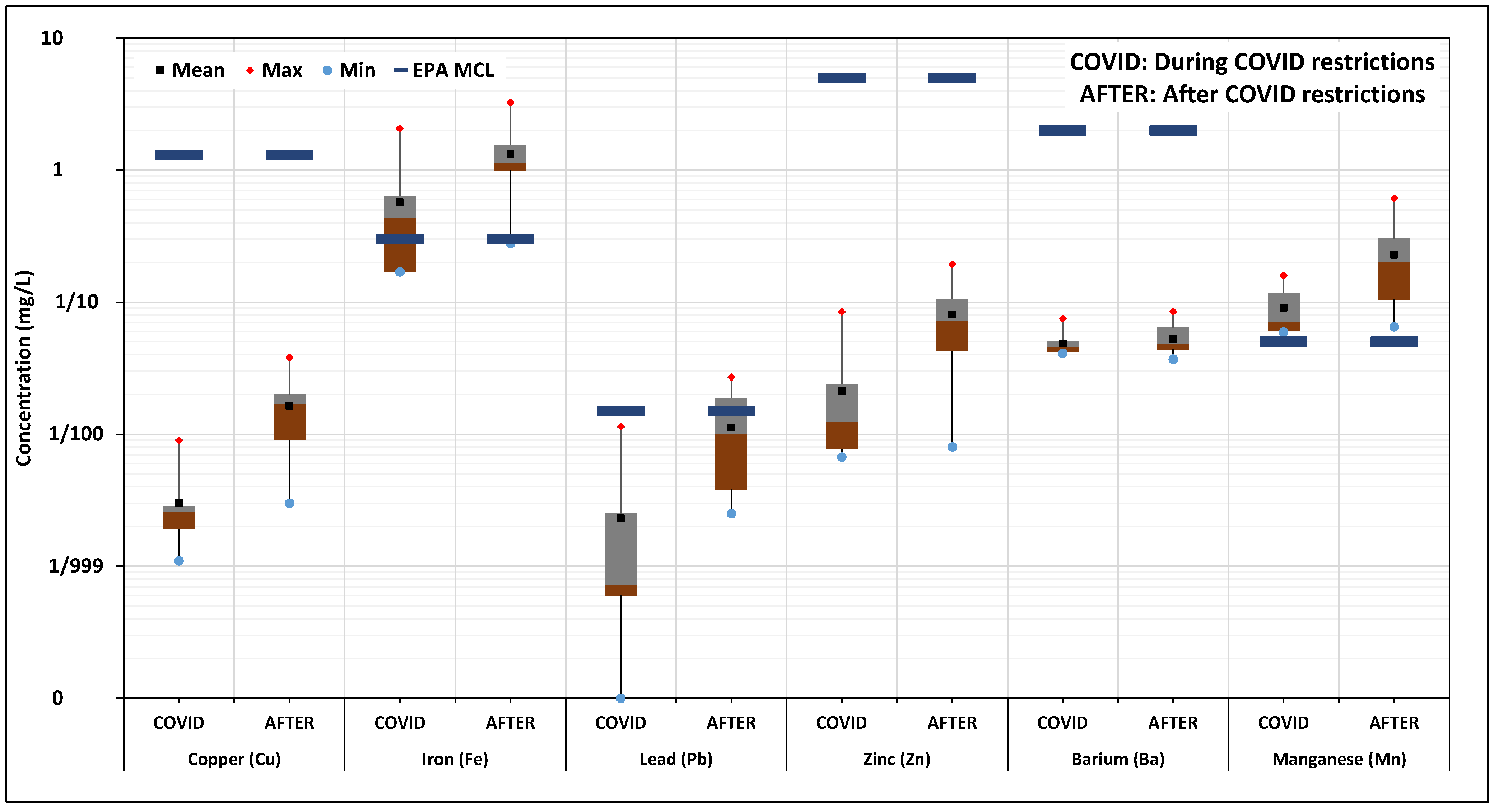
References
- Haque, S.E. Urban Water Pollution by Heavy Metals, Microplastics, and Organic Contaminants, 1st ed.; Elsevier Inc.: Philadelphia, PA, USA, 2022; Volume 6, ISBN 9780323918381. [Google Scholar]
- Song, Y.; Song, X.; Shao, G. Response of Water Quality to Landscape Patterns in an Urbanized Watershed in Hangzhou, China. Sustainability 2020, 12, 5500. [Google Scholar] [CrossRef]
- Sun, Y.; Guo, Q.; Liu, J.; Wang, R. Scale Effects on Spatially Varying Relationships between Urban Landscape Patterns and Water Quality. Environ. Manag. 2014, 54, 272–287. [Google Scholar] [CrossRef] [PubMed]
- Chowdhury, A.; Egodawatta, P.; McGree, J. Pattern-Based Assessment of the Influence of Catchment Characteristics on Urban Stormwater Quality. Water Sci. Technol. 2024, 90, 2441–2455. [Google Scholar] [CrossRef]
- Khatri, N.; Tyagi, S. Influences of Natural and Anthropogenic Factors on Surface and Groundwater Quality in Rural and Urban Areas. Front. Life Sci. 2015, 8, 23–39. [Google Scholar] [CrossRef]
- Rathi, B.S.; Kumar, P.S.; Vo, D.V.N. Critical Review on Hazardous Pollutants in Water Environment: Occurrence, Monitoring, Fate, Removal Technologies and Risk Assessment. Sci. Total Environ. 2021, 797, 149134. [Google Scholar] [CrossRef]
- Gabr, M.E.; El Shorbagy, A.M.; Faheem, H.B. Assessment of Stormwater Quality in the Context of Traffic Congestion: A Case Study in Egypt. Sustainability 2023, 15, 13927. [Google Scholar] [CrossRef]
- Liu, A.; Ma, Y.; Gunawardena, J.M.A.; Egodawatta, P.; Ayoko, G.A.; Goonetilleke, A. Heavy Metals Transport Pathways: The Importance of Atmospheric Pollution Contributing to Stormwater Pollution. Ecotoxicol. Environ. Saf. 2018, 164, 696–703. [Google Scholar] [CrossRef]
- Müller, A.; Österlund, H.; Marsalek, J.; Viklander, M. The Pollution Conveyed by Urban Runoff: A Review of Sources. Sci. Total Environ. 2020, 709, 136125. [Google Scholar] [CrossRef]
- Markiewicz, A.; Björklund, K.; Eriksson, E.; Kalmykova, Y.; Strömvall, A.M.; Siopi, A. Emissions of Organic Pollutants from Traffic and Roads: Priority Pollutants Selection and Substance Flow Analysis. Sci. Total Environ. 2017, 580, 1162–1174. [Google Scholar] [CrossRef]
- Fallah Shorshani, M.; Bonhomme, C.; Petrucci, G.; André, M.; Seigneur, C. Road Traffic Impact on Urban Water Quality: A Step towards Integrated Traffic, Air and Stormwater Modelling. Environ. Sci. Pollut. Res. 2014, 21, 5297–5310. [Google Scholar] [CrossRef]
- Teixidó, M.; Schmidlin, D.; Xu, J.; Scheiber, L.; Chesa, M.J.; Vázquez-Suñé, E. Contaminants in Urban Stormwater: Barcelona Case Study. Adv. Geosci. 2023, 59, 69–76. [Google Scholar] [CrossRef]
- Järlskog, I.; Strömvall, A.M.; Magnusson, K.; Galfi, H.; Björklund, K.; Polukarova, M.; Garção, R.; Markiewicz, A.; Aronsson, M.; Gustafsson, M.; et al. Traffic-Related Microplastic Particles, Metals, and Organic Pollutants in an Urban Area under Reconstruction. Sci. Total Environ. 2021, 774, 145503. [Google Scholar] [CrossRef] [PubMed]
- Hwang, H.M.; Fiala, M.J.; Park, D.; Wade, T.L. Review of Pollutants in Urban Road Dust and Stormwater Runoff: Part 1. Heavy Metals Released from Vehicles. Int. J. Urban Sci. 2016, 20, 334–360. [Google Scholar] [CrossRef]
- Liu, A.; Mummullage, S.; Ma, Y.; Egodawatta, P.; Ayoko, G.A.; Goonetilleke, A. Linking Source Characterisation and Human Health Risk Assessment of Metals to Rainfall Characteristics. Environ. Pollut. 2018, 238, 866–873. [Google Scholar] [CrossRef]
- DDPHE Regulation NO. 38—Classifications and Numeric Standards for South Platte River Basin, Laramie River Basin, Republican River Basin, Smoky Hill River Basin. 2021; Volume 2021. Available online: https://19january2021snapshot.epa.gov/sites/static/files/2014-12/documents/cowqs-no38-2006.pdf (accessed on 1 October 2024).
- Gustafson, K.R.; Garcia-Chevesich, P.A.; Slinski, K.M.; Sharp, J.O.; McCray, J.E. Quantifying the Effects of Residential Infill Redevelopment on Urban Stormwater Quality in Denver, Colorado. Water 2021, 13, 988. [Google Scholar] [CrossRef]
- Pilone, F.G.; Garcia-Chevesich, P.A.; McCray, J.E. Urban Drool Water Quality in Denver, Colorado: Pollutant Occurrences and Sources in Dry-Weather Flows. Water 2021, 13, 3436. [Google Scholar] [CrossRef]
- Ali, H.; Khan, E.; Ilahi, I. Environmental Chemistry and Ecotoxicology of Hazardous Heavy Metals: Environmental Persistence, Toxicity, and Bioaccumulation. J. Chem. 2019, 2019, 6730305. [Google Scholar] [CrossRef]
- Ma, Y.; Liu, A.; Egodawatta, P.; McGree, J.; Goonetilleke, A. Assessment and Management of Human Health Risk from Toxic Metals and Polycyclic Aromatic Hydrocarbons in Urban Stormwater Arising from Anthropogenic Activities and Traffic Congestion. Sci. Total Environ. 2017, 579, 202–211. [Google Scholar] [CrossRef]
- Ghazy, M.M.E.D.; Habashy, M.M.; Nassif, M.G. The Acute Toxic Impact of Iron (Fe) and Lead (Pb) Individually and Their Mixture on Daphnia Magna (Straus, 1820). Egypt. J. Aquat. Biol. Fish. 2024, 28, 675–683. [Google Scholar] [CrossRef]
- Baden, S.P.; Eriksson, S.P. Role, Routes and Effects of Manganese in Crustaceans. Oceanogr. Mar. Biol. 2006, 44, 61–83. [Google Scholar] [CrossRef]
- Wang, X.; Liu, B.L.; Gao, X.Q.; Fang, Y.Y.; Zhang, X.H.; Cao, S.Q.; Zhao, K.F.; Wang, F. Effect of Long-Term Manganese Exposure on Oxidative Stress, Liver Damage and Apoptosis in Grouper Epinephelus moara ♀ × Epinephelus lanceolatus ♂. Front. Mar. Sci. 2022, 9, 1000282. [Google Scholar] [CrossRef]
- Iyare, P.U. The Effects of Manganese Exposure from Drinking Water on School-Age Children: A Systematic Review. Neurotoxicology 2019, 73, 1–7. [Google Scholar] [CrossRef] [PubMed]
- Ashar, Y.K.; Wulandari Panjaitan, N.; Iqbal, M.; Imron, H. Iron (Fe) Content in Community Well Water around Mabar Hilir Industrial Area Market 3 Bantenan Medan City in the Perspective of Health and Islamic. Contag. Sci. Period. J. Public Heal. Coast. Health 2023, 5, 294–301. [Google Scholar] [CrossRef]
- Lidman, J.; Jonsson, M.; Berglund, Å.M.M. The Effect of Lead (Pb) and Zinc (Zn) Contamination on Aquatic Insect Community Composition and Metamorphosis. Sci. Total Environ. 2020, 734, 139406. [Google Scholar] [CrossRef]
- Lee, J.W.; Choi, H.; Hwang, U.K.; Kang, J.C.; Kang, Y.J.; Kim, K.I.; Kim, J.H. Toxic Effects of Lead Exposure on Bioaccumulation, Oxidative Stress, Neurotoxicity, and Immune Responses in Fish: A Review. Environ. Toxicol. Pharmacol. 2019, 68, 101–108. [Google Scholar] [CrossRef]
- Fakhri, Y.; Saha, N.; Ghanbari, S.; Rasouli, M.; Miri, A.; Avazpour, M.; Rahimizadeh, A.; Riahi, S.M.; Ghaderpoori, M.; Keramati, H.; et al. Carcinogenic and Non-Carcinogenic Health Risks of Metal(Oid)s in Tap Water from Ilam City, Iran. Food Chem. Toxicol. 2018, 118, 204–211. [Google Scholar] [CrossRef]
- Gunawardena, J.; Ziyath, A.M.; Egodawatta, P.; Ayoko, G.A.; Goonetilleke, A. Mathematical Relationships for Metal Build-up on Urban Road Surfaces Based on Traffic and Land Use Characteristics. Chemosphere 2014, 99, 267–271. [Google Scholar] [CrossRef]
- Czemiel Berndtsson, J. Storm Water Quality of First Flush Urban Runoff in Relation to Different Traffic Characteristics. Urban Water J. 2014, 11, 284–296. [Google Scholar] [CrossRef]
- Clements, N.; Hannigan, M.P.; Miller, S.L.; Peel, J.L.; Milford, J.B. Comparisons of Urban and Rural PM10-2.5 and PM2.5 Mass Concentrations and Semi-Volatile Fractions in Northeastern Colorado. Atmos. Chem. Phys. 2016, 16, 7469–7484. [Google Scholar] [CrossRef]
- Ransom, M.R.; Kelemen, T. The Impact of Light Rail on Congestion in Denver: A Reappraisal. J. Transp. Geogr. 2016, 54, 214–217. [Google Scholar] [CrossRef]
- Husch Blackwell. State-By-State COVID Guidance: Colorado. Available online: https://www.huschblackwell.com/colorado-state-by-state-covid-19-guidance (accessed on 16 April 2023).
- NOAA. Denver’s 2019 Climate Year in Review. Available online: https://www.weather.gov/bou/Denver_2019_climate_summary (accessed on 23 September 2023).
- Alexandrino, K.; Viteri, F.; Rybarczyk, Y.; Guevara Andino, J.E.; Zalakeviciute, R. Biomonitoring of Metal Levels in Urban Areas with Different Vehicular Traffic Intensity by Using Araucaria Heterophylla Needles. Ecol. Indic. 2020, 117, 106701. [Google Scholar] [CrossRef]
- Galvez, M.C.; Vallar, E.; Castilla, R.; Mandia, P.; Branzuela, R.; Rempillo, O.; Orbecido, A.; Beltran, A.; Ledesma, N.; Deocaris, C.; et al. Principal Component Analysis of Heavy Metals in Atmos-Pheric Aerosols from Meycauayan, Bulacan, Philippines. Preprints 2022. [Google Scholar] [CrossRef]
- Huber, M.; Helmreich, B. Stormwater Management: Calculation of Traffic Area Runoff Loads and Traffic Related Emissions. Water 2016, 8, 294. [Google Scholar] [CrossRef]
- Wang, J.M.; Jeong, C.H.; Hilker, N.; Healy, R.M.; Sofowote, U.; Debosz, J.; Su, Y.; Munoz, A.; Evans, G.J. Quantifying Metal Emissions from Vehicular Traffic Using Real World Emission Factors. Environ. Pollut. 2020, 268, 115805. [Google Scholar] [CrossRef]
- Jia, Y.; Peng, L.; Mu, L. The Chemical Composition and Sources of PM 10 in Urban Road Dust. Appl. Mech. Mater. 2011, 71–78, 2749–2752. [Google Scholar] [CrossRef]
- Cornelis, J.T.; Delvaux, B. Soil Processes Drive the Biological Silicon Feedback Loop. Funct. Ecol. 2016, 30, 1298–1310. [Google Scholar] [CrossRef]
- Cornelis, R.; Nordberg, M. General Chemistry, Sampling, Analytical Methods, and Speciation. In Handbook of the Toxicology of Metals, 3rd ed.; Academic Press: London, UK, 2007; pp. 11–38. [Google Scholar] [CrossRef]
- EPA. National Management Measures for the Control of Nonpoint Pollution from Agriculture: Load Estimation Techniques; US Environmental Protection Agency, Office of Water: Washington, DC, USA, 2003.
- Gao, Z.; Zhang, Q.; Li, J.; Wang, Y.; Dzakpasu, M.; Wang, X.C. First Flush Stormwater Pollution in Urban Catchments: A Review of Its Characterization and Quantification towards Optimization of Control Measures. J. Environ. Manag. 2023, 340, 117976. [Google Scholar] [CrossRef]
- Tomtom Traffic Data & Traffic Stats|TomTom. Available online: https://www.tomtom.com/products/traffic-stats/ (accessed on 16 April 2023).
- USEPA. National Primary Drinking Water Regulations. Available online: https://www.epa.gov/ground-water-and-drinking-water/national-primary-drinking-water-regulations (accessed on 6 December 2024).
- USEPA. Secondary Drinking Water Standards: Guidance for Nuisance Chemicals. Available online: https://www.epa.gov/sdwa/secondary-drinking-water-standards-guidance-nuisance-chemicals (accessed on 6 December 2024).
- Denverwater. Managing Water Chemistry. Available online: https://www.denverwater.org/your-water/water-quality/lead/ph#:~:text=Sincemid-2020%2Caspart,withatargetof8.8 (accessed on 26 September 2024).
- Lewis, W.M.; Grant, M.C. Acid Precipitation in the Western United States. Science 1980, 207, 176–177. [Google Scholar] [CrossRef]
- Schroder, L.J.; Hedley, A.G. Variation in Precipitation Quality during a 40-hour Snowstorm in an Urban Environment—Denver, Colorado. Int. J. Environ. Stud. 1986, 28, 131–138. [Google Scholar] [CrossRef]
- Baker, J.P.; Bernard, D.P.; Christensen, S.W.; Sale, M.J.; Freda, J.; Heltcher, K.; Marmorek, D.; Rowe, L.; Scanlon, P.; Suter, G.; et al. Biological Effects of Changes in Surface Water Acid-Base Chemistry; Oak Ridge National Lab.: Oak Ridge, TN, USA, 1990. [Google Scholar]
- Driscoll, C.T.; Lawrence, G.B.; Bulger, A.J.; Butler, T.J.; Cronan, C.S.; Eagar, C.; Lambert, K.F.; Likens, G.E.; Stoddard, J.L.; Weathers, K.C. Acidic Deposition in the Northeastern United States: Sources and Inputs, Ecosystem Effects, and Management Strategies. Bioscience 2001, 51, 180–198. [Google Scholar] [CrossRef]
- Arhin, E.; Osei, J.D.; Anima, P.A.; Afari, P.D.; Yevugah, L.L. The PH of Drinking Water and Its Human Health Implications: A Case of Surrounding Communities in the Dormaa Central Municipality of Ghana. J. Healthc. Treat. Dev. 2023, 4, 15–26. [Google Scholar] [CrossRef]
- Kuang, X.; Sansalone, J. Cementitious Porous Pavement in Stormwater Quality Control: PH and Alkalinity Elevation. Water Sci. Technol. 2011, 63, 2992–2998. [Google Scholar] [CrossRef] [PubMed]
- Kazemi, F.; Hill, K. Effect of Permeable Pavement Basecourse Aggregates on Stormwater Quality for Irrigation Reuse. Ecol. Eng. 2015, 77, 189–195. [Google Scholar] [CrossRef]
- Bernardino, C.A.R.; Mahler, C.F.; Santelli, R.E.; Freire, A.S.; Braz, B.F.; Novo, L.A.B. Metal Accumulation in Roadside Soils of Rio de Janeiro, Brazil: Impact of Traffic Volume, Road Age, and Urbanization Level. Environ. Monit. Assess. 2019, 191, 156. [Google Scholar] [CrossRef] [PubMed]
- Shajib, M.T.I.; Hansen, H.C.B.; Liang, T.; Holm, P.E. Metals in Surface Specific Urban Runoff in Beijing. Environ. Pollut. 2019, 248, 584–598. [Google Scholar] [CrossRef]
- Müller, A.; Österlund, H.; Marsalek, J.; Viklander, M. Exploiting Urban Roadside Snowbanks as Passive Samplers of Organic Micropollutants and Metals Generated by Traffic. Environ. Pollut. 2022, 308, 119723. [Google Scholar] [CrossRef]
- Li, W.; Shen, Z.; Tian, T.; Liu, R.; Qiu, J. Temporal Variation of Heavy Metal Pollution in Urban Stormwater Runoff. Front. Environ. Sci. Eng. China 2012, 6, 692–700. [Google Scholar] [CrossRef]
- Hallberg, M.; Renman, G.; Lundbom, T. Seasonal Variations of Ten Metals in Highway Runoff and Their Partition between Dissolved and Particulate Matter. Water. Air. Soil Pollut. 2007, 181, 183–191. [Google Scholar] [CrossRef]
- Lee, B.-C.; Matsui, S.; Shimizu, Y.; Matsuda, T. Characterizations of the First Flush in Storm Water Runoff from an Urban Roadway. Environ. Technol. 2005, 26, 773–782. [Google Scholar] [CrossRef]
- Quraishi, A.G.M. Domestic Water Use in Sweden. J. AWWA 1963, 55, 451–455. [Google Scholar] [CrossRef]
- Mizukami, Y.; Kawashima, M. Chemical Study of Precipitation by Lake Biwa at Otsu, Shiga, Japan. Bull. Fac. Educ. Shiga Univ. 2017, 66, 119–133. [Google Scholar]
- Ma, Y.; Egodawatta, P.; McGree, J.; Liu, A.; Goonetilleke, A. Human Health Risk Assessment of Heavy Metals in Urban Stormwater. Sci. Total Environ. 2016, 557–558, 764–772. [Google Scholar] [CrossRef] [PubMed]
- Barrett, M.E.; Irish, L.B.; Malina, J.F.; Charbeneau, R.J. Characterization of Highway Runoff in Austin, Texas, Area. J. Environ. Eng. 1998, 124, 131–137. [Google Scholar] [CrossRef]
- Kayhanian, M.; Singh, A.; Suverkropp, C.; Borroum, S. Impact of Annual Average Daily Traffic on Highway Runoff Pollutant Concentrations. J. Environ. Eng. 2003, 129, 975–990. [Google Scholar] [CrossRef]
- Martínez, G.; García-Chevesich, P.A.; Guillen, M.; Tejada-Purizcana, T.; Martinez, K.; Ticona, S.; Novoa, H.M.; Crespo, J.; Holley, E.A.; McCray, J.E. Urban Stormwater Quality in Arequipa, Southern Peru: An Initial Assessment. Water 2024, 16, 108. [Google Scholar] [CrossRef]
- Corseuil, C.W.; Giehl, M.R.; Pimentel, L.O.; Back, Á.J. Analysis of Rainfall Erosivity in South America: Análise Da Erosividade Da Chuva Na América Do Sul. Concilium 2023, 23, 330–354. [Google Scholar] [CrossRef]
- Flint, K.R.; Davis, A.P. Pollutant Mass Flushing Characterization of Highway Stormwater Runoff from an Ultra-Urban Area. J. Environ. Eng. 2007, 133, 616–626. [Google Scholar] [CrossRef]
- Hoffman, E.J.; James, L.S.; Hunt, C.D.; Mills, G.L.; Quinn, J.G. Stormwater Runoff from Highways. Water Air Soil Pollut. 1985, 25, 349–364. [Google Scholar] [CrossRef]
- Maniquiz-Redillas, M.; Robles, M.E.; Cruz, G.; Reyes, N.J.; Kim, L.H. First Flush Stormwater Runoff in Urban Catchments: A Bibliometric and Comprehensive Review. Hydrology 2022, 9, 63. [Google Scholar] [CrossRef]
- Mastouri, R.; Pourfallah Koushali, H.; Khaledian, M.R. The First Flush Analysis of Stormwater Runoff in a Humid Climate. J. Environ. Eng. Landsc. Manag. 2023, 31, 82–91. [Google Scholar] [CrossRef]
- Sansalone, J.J.; Buchberger, S.G. Partitioning and First Flush of Metals in Urban Roadway Storm Water. J. Environ. Eng. 1997, 123, 134–143. [Google Scholar] [CrossRef]
- Shumi, W.; Shugang, G.; Qiang, H.; Wentao, Y.; Li, S. Water Quality Characteristics of Stormwater Runoff and the First Flush Effect in Urban Regions. Res. Environ. Sci. 2015, 28, 532–539. [Google Scholar]
- Bućko, M.S.; Magiera, T.; Johanson, B.; Petrovský, E.; Pesonen, L.J. Identification of Magnetic Particulates in Road Dust Accumulated on Roadside Snow Using Magnetic, Geochemical and Micro-Morphological Analyses. Environ. Pollut. 2011, 159, 1266–1276. [Google Scholar] [CrossRef] [PubMed]
- Apeagyei, E.; Bank, M.S.; Spengler, J.D. Distribution of Heavy Metals in Road Dust along an Urban-Rural Gradient in Massachusetts. Atmos. Environ. 2011, 45, 2310–2323. [Google Scholar] [CrossRef]
- Dang, D.P.T.; Jean-Soro, L.; Béchet, B. Pollutant Characteristics and Size Distribution of Trace Elements during Stormwater Runoff Events. Environ. Chall. 2023, 11, 100682. [Google Scholar] [CrossRef]
- Harantová, V.; Hájnik, A.; Kalašová, A.; Figlus, T. The Effect of the COVID-19 Pandemic on Traffic Flow Characteristics, Emissions Production and Fuel Consumption at a Selected Intersection in Slovakia. Energies 2022, 15, 2020. [Google Scholar] [CrossRef]
- Haghnazar, H.; Cunningham, J.A.; Kumar, V.; Aghayani, E.; Mehraein, M. COVID-19 and Urban Rivers: Effects of Lockdown Period on Surface Water Pollution and Quality—A Case Study of the Zarjoub River, North of Iran. Environ. Sci. Pollut. Res. 2022, 29, 27382–27398. [Google Scholar] [CrossRef]
- Chakraborty, B.; Roy, S.; Bera, A.; Adhikary, P.P.; Bera, B.; Sengupta, D.; Bhunia, G.S.; Shit, P.K. Cleaning the River Damodar (India): Impact of COVID-19 Lockdown on Water Quality and Future Rejuvenation Strategies. Environ. Dev. Sustain. 2021, 23, 11975–11989. [Google Scholar] [CrossRef]
- Lesley, B.; Daniel, H.; Paul, Y. Iron and Manganese Removal in Wetland Treatment Systems: Rates, Processes and Implications for Management. Sci. Total Environ. 2008, 394, 1–8. [Google Scholar] [CrossRef]
- Hatt, B.E.; Fletcher, T.D.; Deletic, A. Pollutant Removal Performance of Field-Scale Stormwater Biofiltration Systems. Water Sci. Technol. 2009, 59, 1567–1576. [Google Scholar] [CrossRef]
- Grebel, J.E.; Mohanty, S.K.; Torkelson, A.A.; Boehm, A.B.; Higgins, C.P.; Maxwell, R.M.; Nelson, K.L.; Sedlak, D.L. Engineered Infiltration Systems for Urban Stormwater Reclamation. Environ. Eng. Sci. 2013, 30, 437–454. [Google Scholar] [CrossRef]
- Walker, D.J.; Hurl, S. The Reduction of Heavy Metals in a Stormwater Wetland. Ecol. Eng. 2002, 18, 407–414. [Google Scholar] [CrossRef]
- Jacklin, D.M.; Brink, I.C.; Jacobs, S.M. Urban Stormwater Nutrient and Metal Removal in Small-Scale Green Infrastructure: Exploring Engineered Plant Biofilter Media Optimisation. Water Sci. Technol. 2021, 84, 1715–1731. [Google Scholar] [CrossRef] [PubMed]
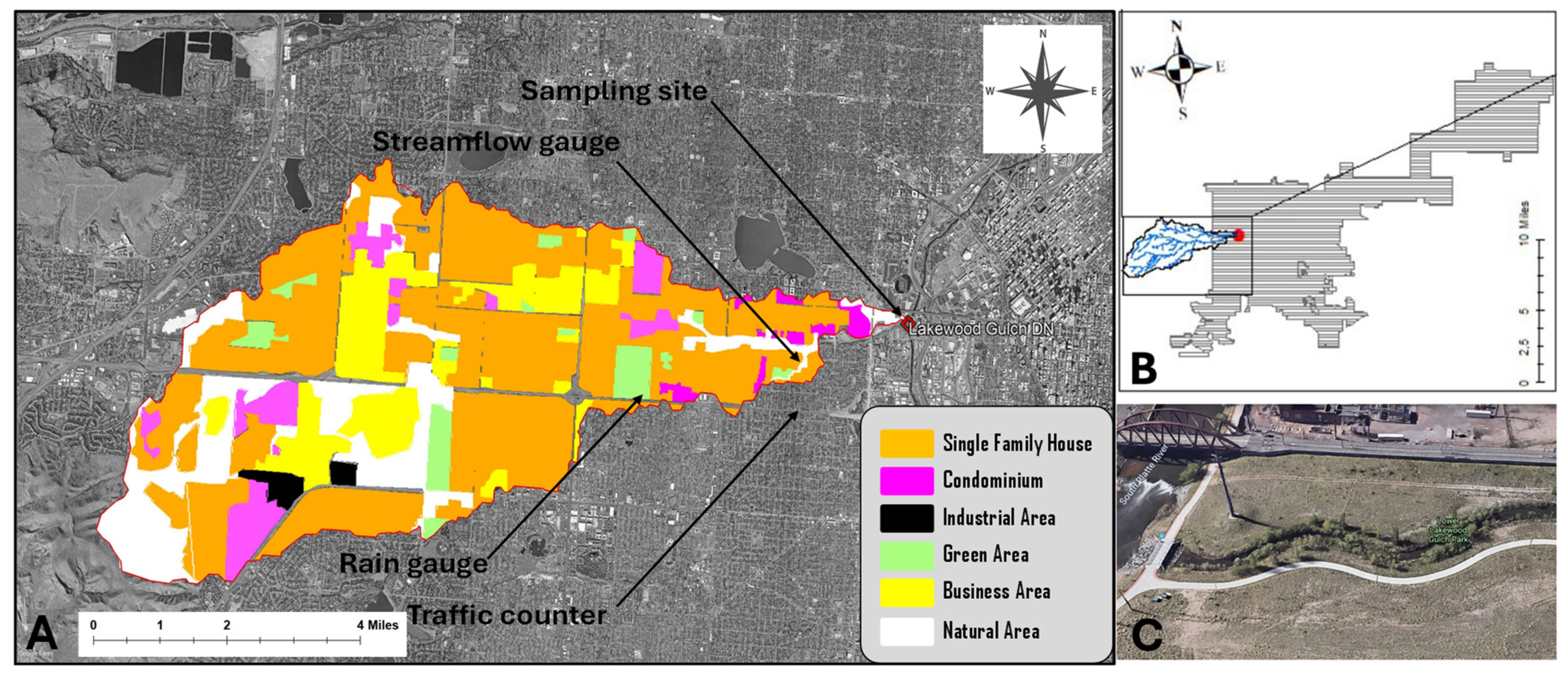
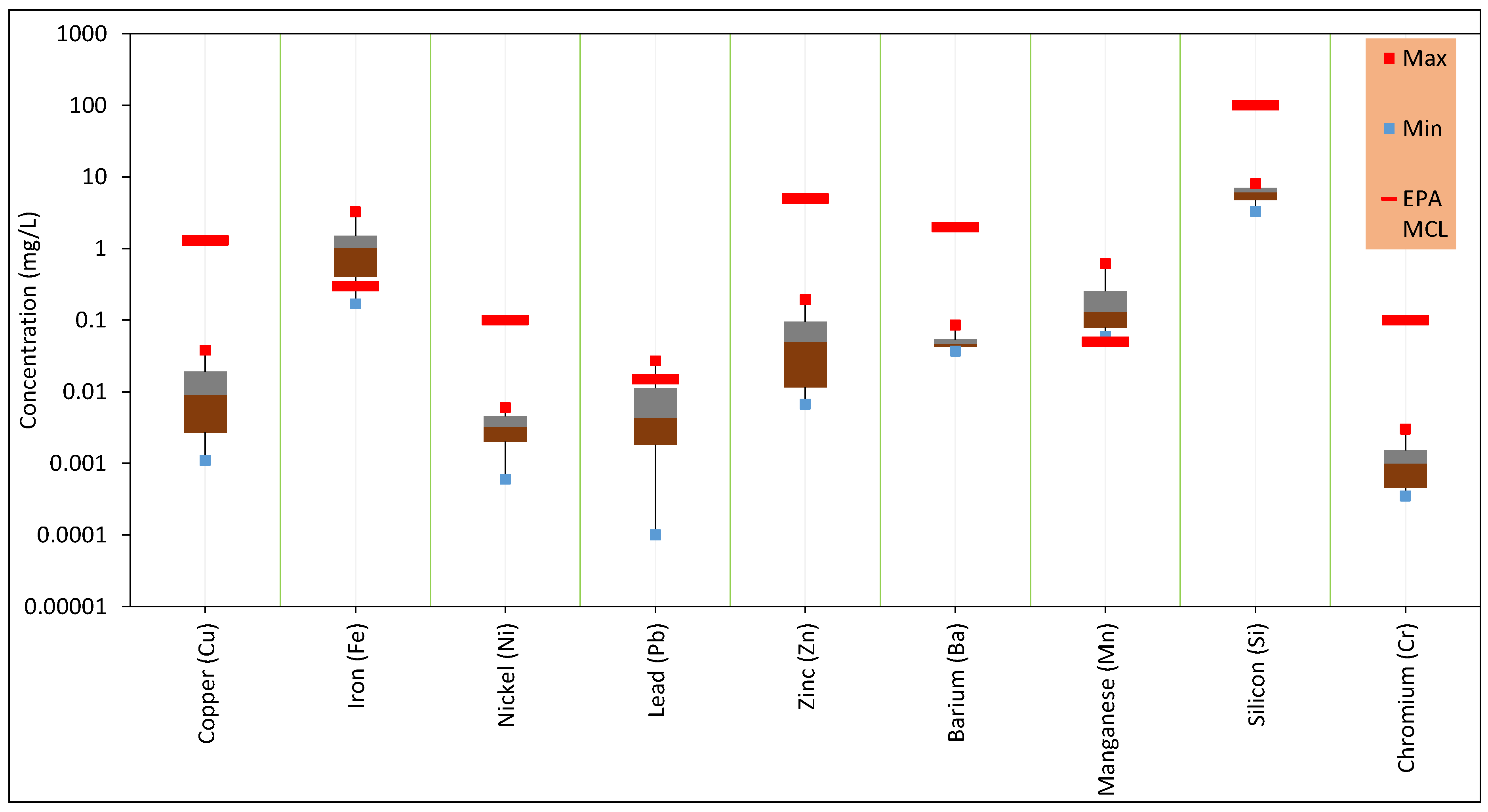

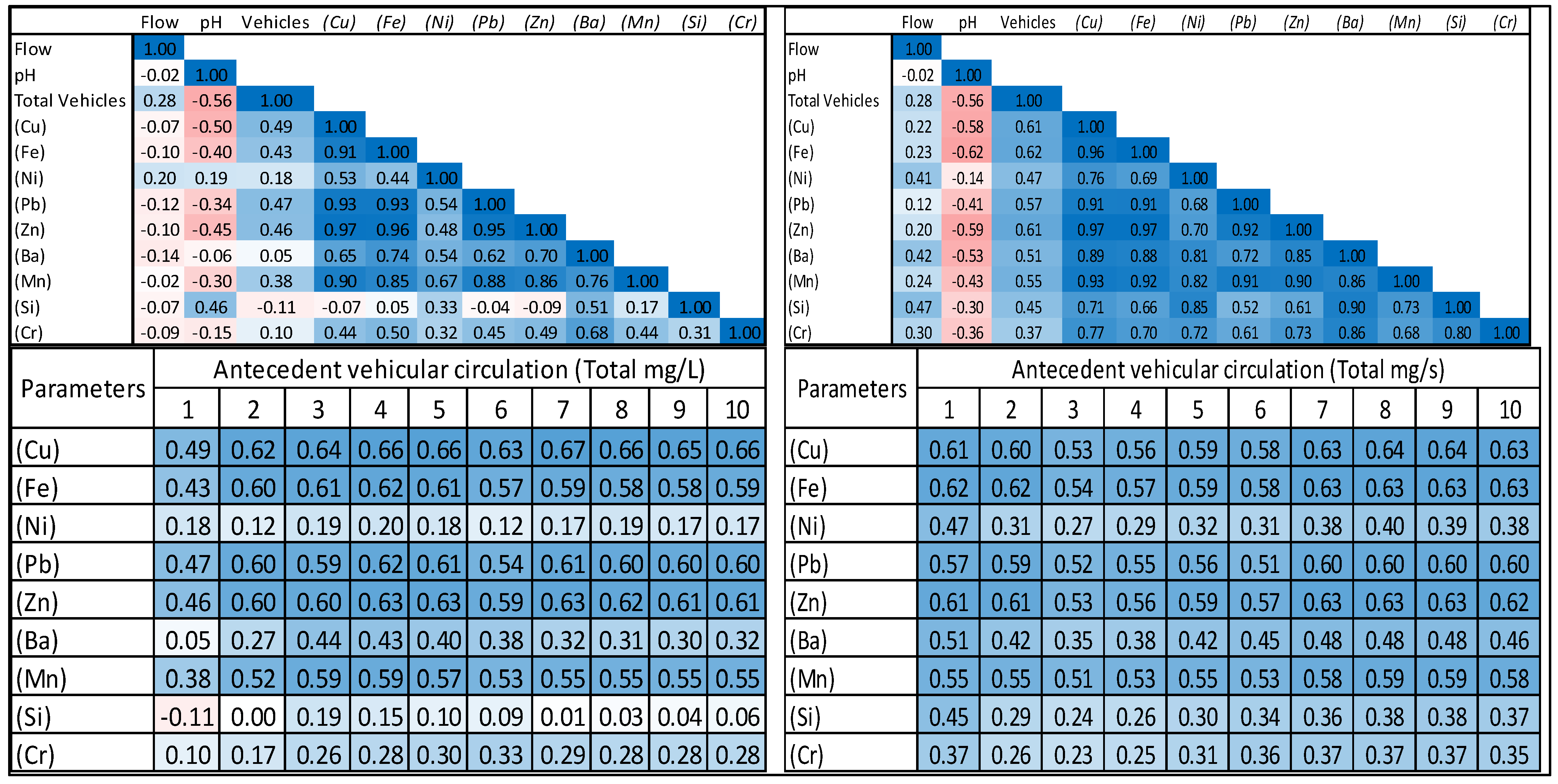
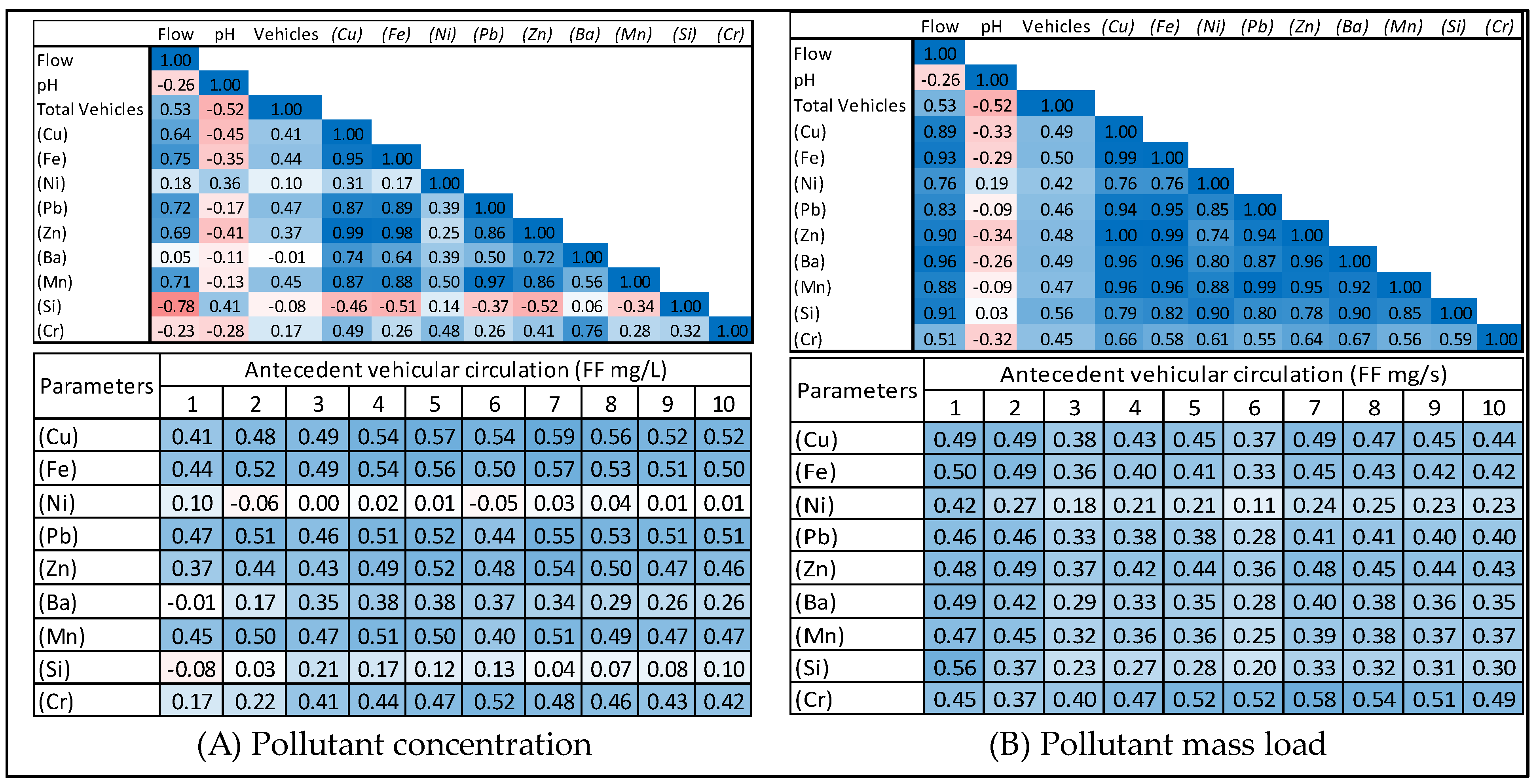
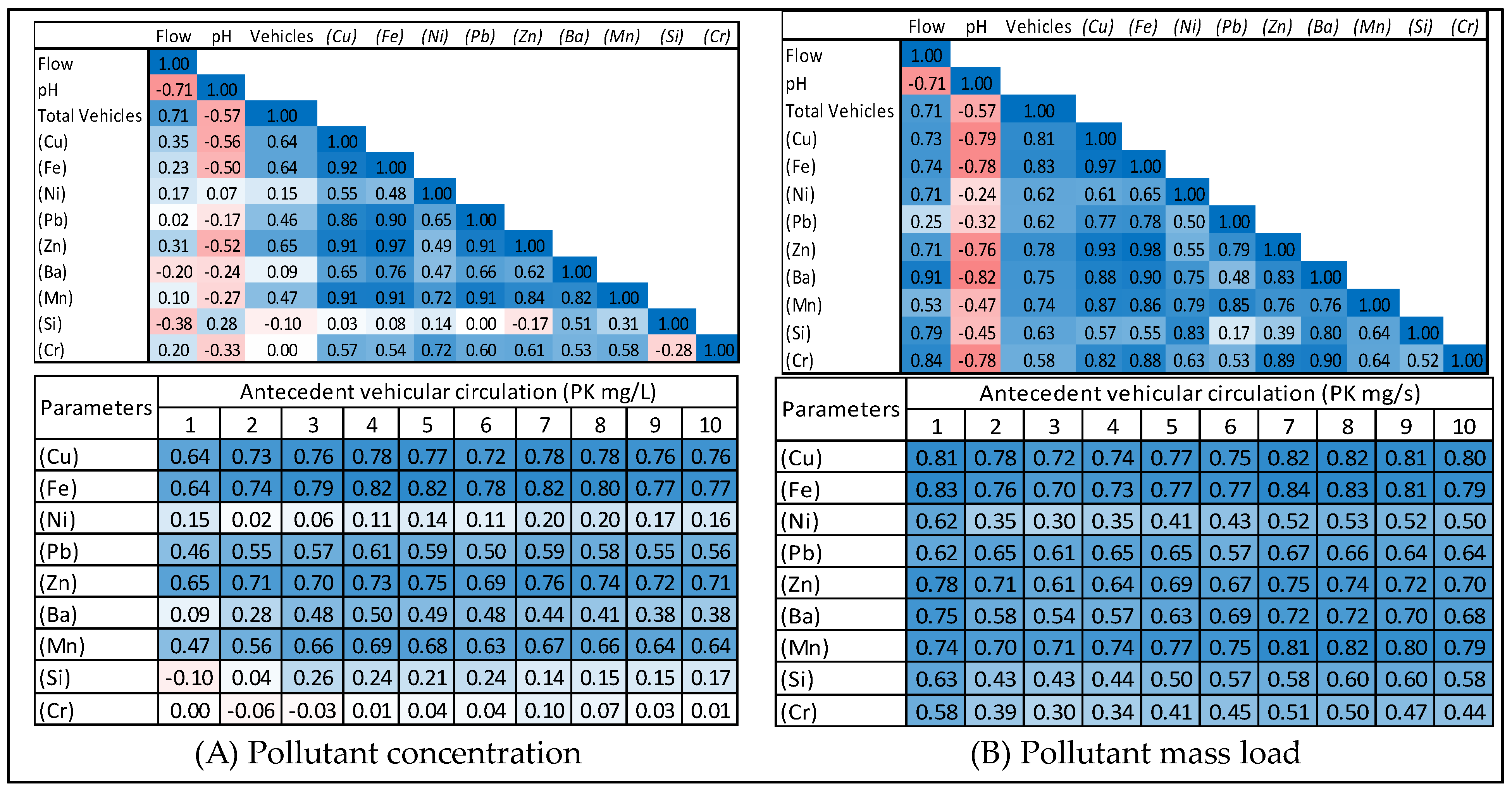
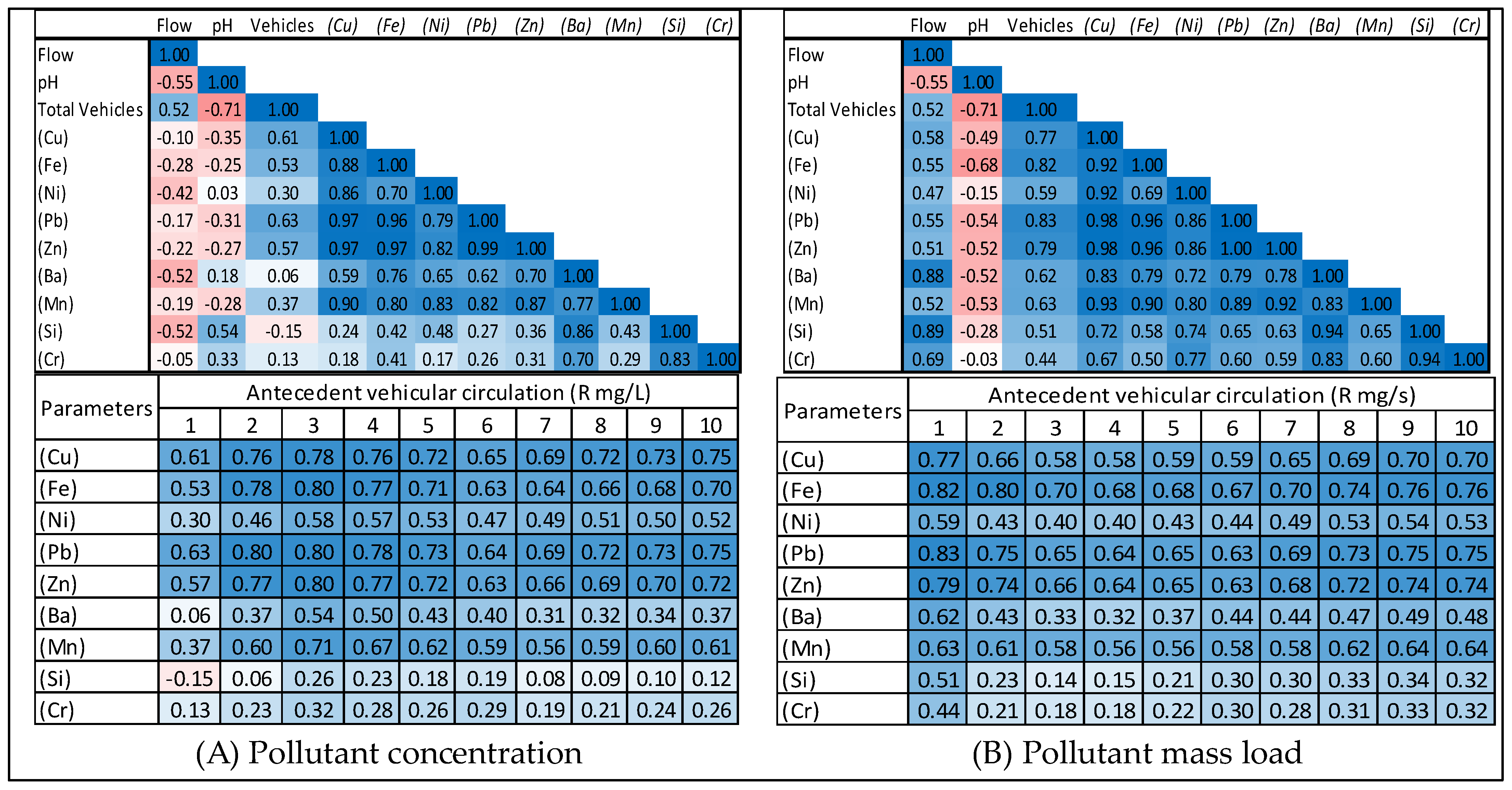
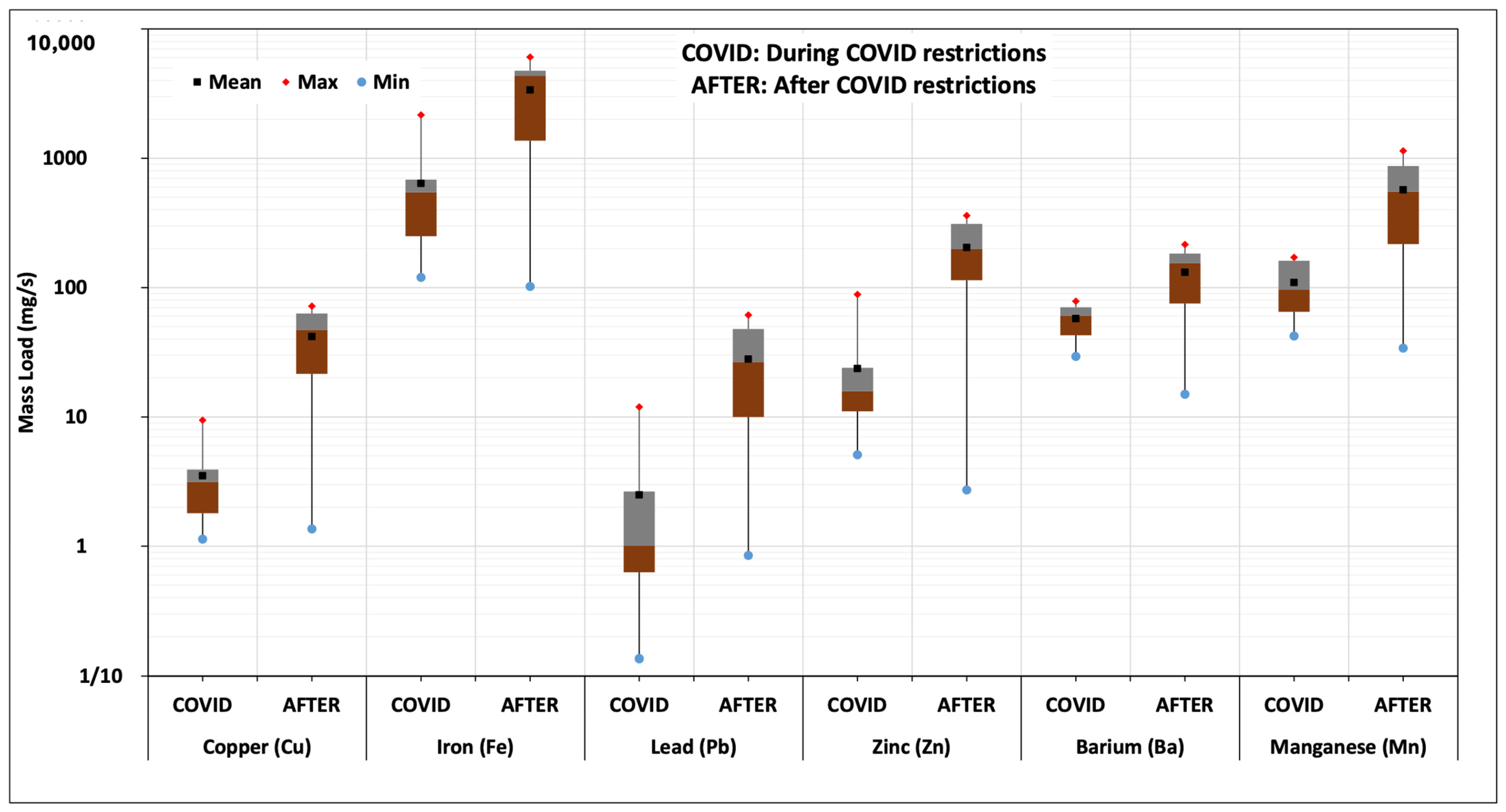
| Cu | Fe | Ni | Pb | Zn | Ba | Mn | Si | Cr | |
|---|---|---|---|---|---|---|---|---|---|
| EPA’s MCL | 1.0 S | 0.3 S | 0.1 S | 0.015 P | 5.0 S | 2.0 P | 0.05 S | 100 S | 0.1 P |
| Date | Time | Hydrograph Stage | ADD | Flow (cfs) | pH | Cond. (μmhos) | Traffic During ADD |
|---|---|---|---|---|---|---|---|
| 11-Apr-20 | 12:30 | Ff | 8 | 25 | 8.39 | 693 | 679,294 |
| 19:05 | Pk | 8 | 56 | 8.39 | 442 | 713,375 | |
| 21:35 | R | 8 | 48 | 8.39 | 439 | 719,330 | |
| 15-May-20 | 20:30 | FF | 12 | 49 | 8.66 | 1112 | 1,400,726 |
| 20:49 | PK | 12 | 383 | 8.48 | 750 | 1,402,221 | |
| 21:05 | R | 12 | 198 | 8.54 | 568 | 1,403,715 | |
| 6-Jun-20 | 15:55 | Ff | 12 | 26 | 8.40 | 742 | 1,567,421 |
| 16:07 | Pk | 12 | 39 | 8.00 | 416 | 1,568,231 | |
| 16:20 | R | 12 | 37 | 7.99 | 714 | 1,570,545 | |
| 6-Apr-21 | 15:20 | Ff | 6 | 74 | 4.68 | 1266 | 928,483 |
| 15:55 | Pk | 6 | 169 | 4.68 | 933 | 937,824 | |
| 16:30 | R | 6 | 144 | 4.47 | 860 | 947,007 | |
| 29-Sep-21 | 16:15 | Ff | 8 | 102 | 7.30 | 496 | 1,287,110 |
| 16:30 | Pk | 8 | 110 | 7.30 | 381 | 1,297,355 | |
| 17:45 | R | 8 | 60 | 6.23 | 488 | 1,306,539 | |
| 20-May-22 | 9:24 | Ff | 15 | 12 | 6.23 | 1255 | 2,310,692 |
| 11:40 | Pk | 15 | 108 | 6.21 | 1019 | 2,333,968 | |
| 14:10 | R | 15 | 66 | 6.11 | 680 | 2,350,595 | |
| 29-May-22 | 14:40 | Ff | 5 | 38 | 6.71 | 855 | 832,823 |
| 16:32 | Pk | 5 | 90 | 6.29 | 948 | 841,029 | |
| 17:11 | R | 5 | 32 | 6.75 | 977 | 848,776 | |
| 31-May-22 | 15:58 | Ff | 1 | 41 | 7.00 | 950 | 226,636 |
| 17:27 | Pk | 1 | 180 | 6.85 | 856 | 235,547 | |
| 18:22 | R | 1 | 169 | 6.75 | 695 | 243,541 |
| Date | Stage | Cu | Fe | Ni | Pb | Zn | Ba | Mn | Si | Cr |
|---|---|---|---|---|---|---|---|---|---|---|
| 11-Apr-20 | Ff | 0.002 | 0.169 | 0.003 | 0.001 | 0.007 | 0.041 | 0.060 | 5.070 | 0.000 |
| Pk | 0.003 | 0.170 | 0.004 | 0.002 | 0.008 | 0.042 | 0.061 | 5.071 | 0.001 | |
| R | 0.001 | 0.189 | 0.002 | 0.000 | 0.007 | 0.041 | 0.059 | 5.069 | 0.000 | |
| 15-May-20 | FF | 0.002 | 0.394 | 0.004 | 0.001 | 0.011 | 0.044 | 0.102 | 6.126 | 0.000 |
| PK | 0.002 | 0.433 | 0.004 | 0.001 | 0.012 | 0.048 | 0.112 | 6.738 | 0.000 | |
| R | 0.003 | 0.476 | 0.005 | 0.001 | 0.014 | 0.053 | 0.124 | 7.412 | 0.001 | |
| 6-Jun-20 | Ff | 0.003 | 0.628 | 0.001 | 0.003 | 0.022 | 0.046 | 0.070 | 6.812 | 0.000 |
| Pk | 0.003 | 0.638 | 0.001 | 0.003 | 0.026 | 0.047 | 0.071 | 6.645 | 0.000 | |
| R | 0.009 | 2.067 | 0.002 | 0.011 | 0.085 | 0.075 | 0.159 | 8.032 | 0.003 | |
| 6-Apr-21 | Ff | 0.012 | 1.031 | 0.001 | 0.004 | 0.071 | 0.044 | 0.103 | 3.313 | 0.000 |
| Pk | 0.013 | 1.032 | 0.002 | 0.005 | 0.072 | 0.045 | 0.104 | 3.314 | 0.001 | |
| R | 0.008 | 1.062 | 0.001 | 0.007 | 0.043 | 0.038 | 0.136 | 3.506 | 0.000 | |
| 29-Sep-21 | Ff | 0.019 | 1.551 | 0.004 | 0.019 | 0.106 | 0.049 | 0.302 | 4.308 | 0.001 |
| Pk | 0.020 | 1.552 | 0.005 | 0.020 | 0.107 | 0.050 | 0.303 | 4.309 | 0.002 | |
| R | 0.028 | 2.551 | 0.005 | 0.024 | 0.148 | 0.049 | 0.234 | 4.673 | 0.001 | |
| 20-May-22 | Ff | 0.004 | 0.300 | 0.002 | 0.003 | 0.008 | 0.044 | 0.100 | 7.319 | 0.001 |
| Pk | 0.019 | 1.123 | 0.003 | 0.009 | 0.057 | 0.054 | 0.259 | 7.089 | 0.001 | |
| R | 0.038 | 3.246 | 0.006 | 0.027 | 0.193 | 0.085 | 0.611 | 7.041 | 0.002 | |
| 29-May-22 | Ff | 0.020 | 1.271 | 0.004 | 0.010 | 0.106 | 0.070 | 0.200 | 6.111 | 0.002 |
| Pk | 0.020 | 1.727 | 0.005 | 0.016 | 0.098 | 0.072 | 0.369 | 7.047 | 0.002 | |
| R | 0.017 | 1.424 | 0.005 | 0.011 | 0.083 | 0.064 | 0.305 | 6.856 | 0.001 | |
| 31-May-22 | Ff | 0.003 | 0.277 | 0.003 | 0.003 | 0.011 | 0.037 | 0.065 | 6.240 | 0.001 |
| Pk | 0.009 | 0.739 | 0.004 | 0.003 | 0.039 | 0.042 | 0.149 | 6.132 | 0.001 | |
| R | 0.015 | 0.993 | 0.003 | 0.010 | 0.065 | 0.045 | 0.176 | 5.805 | 0.002 |
Disclaimer/Publisher’s Note: The statements, opinions and data contained in all publications are solely those of the individual author(s) and contributor(s) and not of MDPI and/or the editor(s). MDPI and/or the editor(s) disclaim responsibility for any injury to people or property resulting from any ideas, methods, instructions or products referred to in the content. |
© 2025 by the authors. Licensee MDPI, Basel, Switzerland. This article is an open access article distributed under the terms and conditions of the Creative Commons Attribution (CC BY) license (https://creativecommons.org/licenses/by/4.0/).
Share and Cite
Sabbagh, K.A.; Garcia-Chevesich, P.; McCray, J.E. Impact of COVID-19 Restrictions and Traffic Intensity on Urban Stormwater Quality in Denver, Colorado. Urban Sci. 2025, 9, 81. https://doi.org/10.3390/urbansci9030081
Sabbagh KA, Garcia-Chevesich P, McCray JE. Impact of COVID-19 Restrictions and Traffic Intensity on Urban Stormwater Quality in Denver, Colorado. Urban Science. 2025; 9(3):81. https://doi.org/10.3390/urbansci9030081
Chicago/Turabian StyleSabbagh, Khaled A., Pablo Garcia-Chevesich, and John E. McCray. 2025. "Impact of COVID-19 Restrictions and Traffic Intensity on Urban Stormwater Quality in Denver, Colorado" Urban Science 9, no. 3: 81. https://doi.org/10.3390/urbansci9030081
APA StyleSabbagh, K. A., Garcia-Chevesich, P., & McCray, J. E. (2025). Impact of COVID-19 Restrictions and Traffic Intensity on Urban Stormwater Quality in Denver, Colorado. Urban Science, 9(3), 81. https://doi.org/10.3390/urbansci9030081







